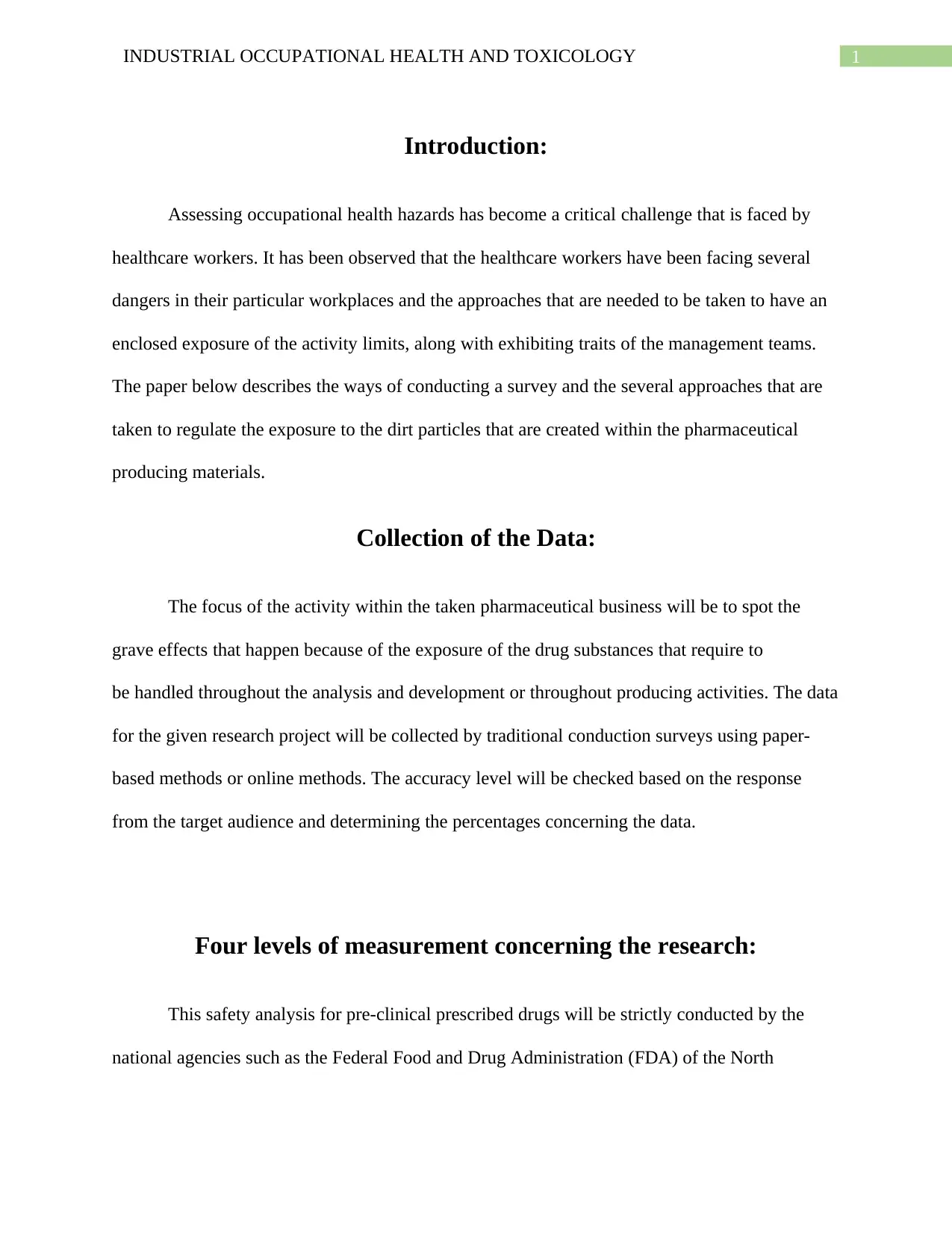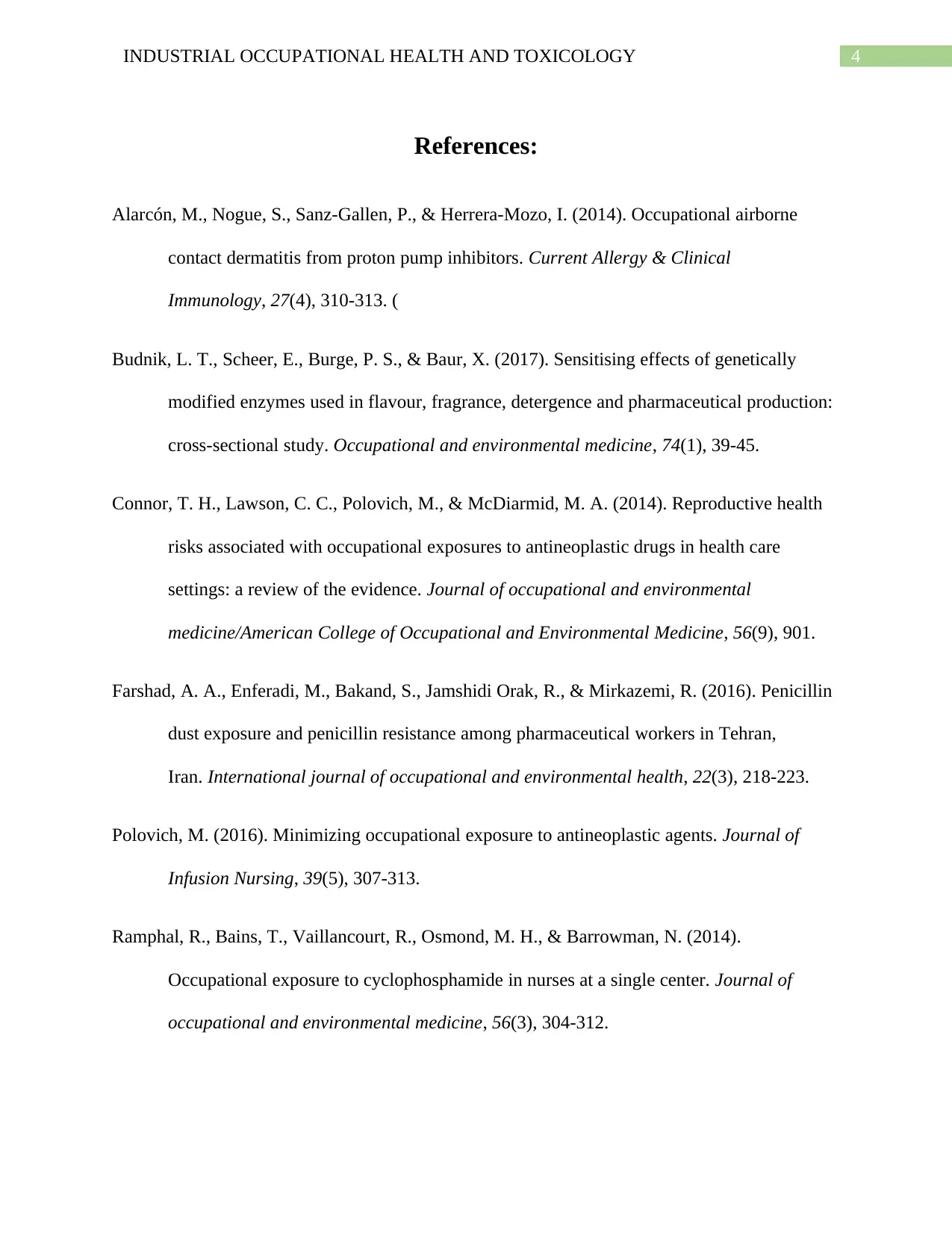Industrial Occupational Health and Toxicology: Survey Analysis Report
VerifiedAdded on 2022/08/21
|5
|1037
|16
Report
AI Summary
This report addresses the critical challenge of assessing occupational health hazards faced by healthcare workers, particularly within the pharmaceutical industry. It outlines a survey methodology for collecting data on exposure to drug substances during research, development, and production. The report details four levels of measurement (nominal, ordinal, interval, and ratio) applicable to the research, along with corresponding statistical tests, including chi-square, frequencies, and parametric tests like t-tests and regression. The analysis focuses on descriptive statistics and the use of clinical trial data and adverse event profiles to provide insights into workplace safety and exposure limits. The report concludes with a list of relevant references to support the findings and methodologies used.

Running Head: INDUSTRIAL OCCUPATIONAL HEALTH AND TOXICOLOGY
INDUSTRIAL OCCUPATIONAL HEALTH AND TOXICOLOGY
Name of the Student:
Name of the University:
Author Note:
INDUSTRIAL OCCUPATIONAL HEALTH AND TOXICOLOGY
Name of the Student:
Name of the University:
Author Note:
Paraphrase This Document
Need a fresh take? Get an instant paraphrase of this document with our AI Paraphraser

1INDUSTRIAL OCCUPATIONAL HEALTH AND TOXICOLOGY
Introduction:
Assessing occupational health hazards has become a critical challenge that is faced by
healthcare workers. It has been observed that the healthcare workers have been facing several
dangers in their particular workplaces and the approaches that are needed to be taken to have an
enclosed exposure of the activity limits, along with exhibiting traits of the management teams.
The paper below describes the ways of conducting a survey and the several approaches that are
taken to regulate the exposure to the dirt particles that are created within the pharmaceutical
producing materials.
Collection of the Data:
The focus of the activity within the taken pharmaceutical business will be to spot the
grave effects that happen because of the exposure of the drug substances that require to
be handled throughout the analysis and development or throughout producing activities. The data
for the given research project will be collected by traditional conduction surveys using paper-
based methods or online methods. The accuracy level will be checked based on the response
from the target audience and determining the percentages concerning the data.
Four levels of measurement concerning the research:
This safety analysis for pre-clinical prescribed drugs will be strictly conducted by the
national agencies such as the Federal Food and Drug Administration (FDA) of the North
Introduction:
Assessing occupational health hazards has become a critical challenge that is faced by
healthcare workers. It has been observed that the healthcare workers have been facing several
dangers in their particular workplaces and the approaches that are needed to be taken to have an
enclosed exposure of the activity limits, along with exhibiting traits of the management teams.
The paper below describes the ways of conducting a survey and the several approaches that are
taken to regulate the exposure to the dirt particles that are created within the pharmaceutical
producing materials.
Collection of the Data:
The focus of the activity within the taken pharmaceutical business will be to spot the
grave effects that happen because of the exposure of the drug substances that require to
be handled throughout the analysis and development or throughout producing activities. The data
for the given research project will be collected by traditional conduction surveys using paper-
based methods or online methods. The accuracy level will be checked based on the response
from the target audience and determining the percentages concerning the data.
Four levels of measurement concerning the research:
This safety analysis for pre-clinical prescribed drugs will be strictly conducted by the
national agencies such as the Federal Food and Drug Administration (FDA) of the North

2INDUSTRIAL OCCUPATIONAL HEALTH AND TOXICOLOGY
American nation, and a wealth of knowledge such as the repetition of the toxicity dosages. The
four levels of measurement that can be applied are summarized below:
Nominal data levels of analysis:
These type of measurement values and reserves the numbers, as such the male and female
respondents. Depending on the data that will be collected, performing any statistical calculations
such as determining the mean and standard deviation on the analytical data will be decided.
Although the nominal variables will be to create tabulations. Moreover, chi-square test will be
used to perform the cross-tabulation for a symbolic set of collected data.
Ordinal data levels of measurement:
Usage of frequencies, specific non-parametric statistics and percentages will be used to
perform statistics with the help of the collected data. Although the standard deviations and the
parametric statistical tests will not be incorporated while using the original data.
Interview scale data levels of measurement:
This is the most commonly used statistical measure that uses the conventional method to
understand the standard deviation and the correlation coefficient. However, using the 5-point
Likert scale for checking the interval scale will be used, which further helps in determining the
difference between the two survey options, whereas the possibilities considered will be: strongly
agree and agree.
American nation, and a wealth of knowledge such as the repetition of the toxicity dosages. The
four levels of measurement that can be applied are summarized below:
Nominal data levels of analysis:
These type of measurement values and reserves the numbers, as such the male and female
respondents. Depending on the data that will be collected, performing any statistical calculations
such as determining the mean and standard deviation on the analytical data will be decided.
Although the nominal variables will be to create tabulations. Moreover, chi-square test will be
used to perform the cross-tabulation for a symbolic set of collected data.
Ordinal data levels of measurement:
Usage of frequencies, specific non-parametric statistics and percentages will be used to
perform statistics with the help of the collected data. Although the standard deviations and the
parametric statistical tests will not be incorporated while using the original data.
Interview scale data levels of measurement:
This is the most commonly used statistical measure that uses the conventional method to
understand the standard deviation and the correlation coefficient. However, using the 5-point
Likert scale for checking the interval scale will be used, which further helps in determining the
difference between the two survey options, whereas the possibilities considered will be: strongly
agree and agree.
⊘ This is a preview!⊘
Do you want full access?
Subscribe today to unlock all pages.

Trusted by 1+ million students worldwide

3INDUSTRIAL OCCUPATIONAL HEALTH AND TOXICOLOGY
Ratio scale data levels of measurement:
The ratio variable that will be found can be used as a dependent variable for performing
the most parametric statistical test such as the t-test, regression, and finding out the correlation.
The usage of the ratio scale data for the measurement will be incorporated for the given research
project as the maximum of the arithmetic operations happen to be based on the ratio variable and
will be dependent for most of the test that will later be performed. This will provide a more
accurate and precise result for the survey that would be conducted.
Statistical test and Analysis:
There are mainly two statistical methods that will be considered to manage the research
work. The descriptive statistics will be performed with the help of summarization of the data by
using indexes such as the mean and the standard deviation. The characterisation seen will be
subjected to the variations caused by random trials. The inferences will be drawn based on the
mathematical statistics that help in dealing with many of the random phenomenon, These data,
which will be obtainable as a bundle of human knowledge from clinical trials and adverse event
profiles of the sold products, square measure. Consulting the analysis chart with the analytics
team will help in providing a clear and useful insight into the plan, thereby making the research
project a successful one.
Ratio scale data levels of measurement:
The ratio variable that will be found can be used as a dependent variable for performing
the most parametric statistical test such as the t-test, regression, and finding out the correlation.
The usage of the ratio scale data for the measurement will be incorporated for the given research
project as the maximum of the arithmetic operations happen to be based on the ratio variable and
will be dependent for most of the test that will later be performed. This will provide a more
accurate and precise result for the survey that would be conducted.
Statistical test and Analysis:
There are mainly two statistical methods that will be considered to manage the research
work. The descriptive statistics will be performed with the help of summarization of the data by
using indexes such as the mean and the standard deviation. The characterisation seen will be
subjected to the variations caused by random trials. The inferences will be drawn based on the
mathematical statistics that help in dealing with many of the random phenomenon, These data,
which will be obtainable as a bundle of human knowledge from clinical trials and adverse event
profiles of the sold products, square measure. Consulting the analysis chart with the analytics
team will help in providing a clear and useful insight into the plan, thereby making the research
project a successful one.
Paraphrase This Document
Need a fresh take? Get an instant paraphrase of this document with our AI Paraphraser

4INDUSTRIAL OCCUPATIONAL HEALTH AND TOXICOLOGY
References:
Alarcón, M., Nogue, S., Sanz-Gallen, P., & Herrera-Mozo, I. (2014). Occupational airborne
contact dermatitis from proton pump inhibitors. Current Allergy & Clinical
Immunology, 27(4), 310-313. (
Budnik, L. T., Scheer, E., Burge, P. S., & Baur, X. (2017). Sensitising effects of genetically
modified enzymes used in flavour, fragrance, detergence and pharmaceutical production:
cross-sectional study. Occupational and environmental medicine, 74(1), 39-45.
Connor, T. H., Lawson, C. C., Polovich, M., & McDiarmid, M. A. (2014). Reproductive health
risks associated with occupational exposures to antineoplastic drugs in health care
settings: a review of the evidence. Journal of occupational and environmental
medicine/American College of Occupational and Environmental Medicine, 56(9), 901.
Farshad, A. A., Enferadi, M., Bakand, S., Jamshidi Orak, R., & Mirkazemi, R. (2016). Penicillin
dust exposure and penicillin resistance among pharmaceutical workers in Tehran,
Iran. International journal of occupational and environmental health, 22(3), 218-223.
Polovich, M. (2016). Minimizing occupational exposure to antineoplastic agents. Journal of
Infusion Nursing, 39(5), 307-313.
Ramphal, R., Bains, T., Vaillancourt, R., Osmond, M. H., & Barrowman, N. (2014).
Occupational exposure to cyclophosphamide in nurses at a single center. Journal of
occupational and environmental medicine, 56(3), 304-312.
References:
Alarcón, M., Nogue, S., Sanz-Gallen, P., & Herrera-Mozo, I. (2014). Occupational airborne
contact dermatitis from proton pump inhibitors. Current Allergy & Clinical
Immunology, 27(4), 310-313. (
Budnik, L. T., Scheer, E., Burge, P. S., & Baur, X. (2017). Sensitising effects of genetically
modified enzymes used in flavour, fragrance, detergence and pharmaceutical production:
cross-sectional study. Occupational and environmental medicine, 74(1), 39-45.
Connor, T. H., Lawson, C. C., Polovich, M., & McDiarmid, M. A. (2014). Reproductive health
risks associated with occupational exposures to antineoplastic drugs in health care
settings: a review of the evidence. Journal of occupational and environmental
medicine/American College of Occupational and Environmental Medicine, 56(9), 901.
Farshad, A. A., Enferadi, M., Bakand, S., Jamshidi Orak, R., & Mirkazemi, R. (2016). Penicillin
dust exposure and penicillin resistance among pharmaceutical workers in Tehran,
Iran. International journal of occupational and environmental health, 22(3), 218-223.
Polovich, M. (2016). Minimizing occupational exposure to antineoplastic agents. Journal of
Infusion Nursing, 39(5), 307-313.
Ramphal, R., Bains, T., Vaillancourt, R., Osmond, M. H., & Barrowman, N. (2014).
Occupational exposure to cyclophosphamide in nurses at a single center. Journal of
occupational and environmental medicine, 56(3), 304-312.
1 out of 5
Related Documents
Your All-in-One AI-Powered Toolkit for Academic Success.
+13062052269
info@desklib.com
Available 24*7 on WhatsApp / Email
![[object Object]](/_next/static/media/star-bottom.7253800d.svg)
Unlock your academic potential
Copyright © 2020–2025 A2Z Services. All Rights Reserved. Developed and managed by ZUCOL.





